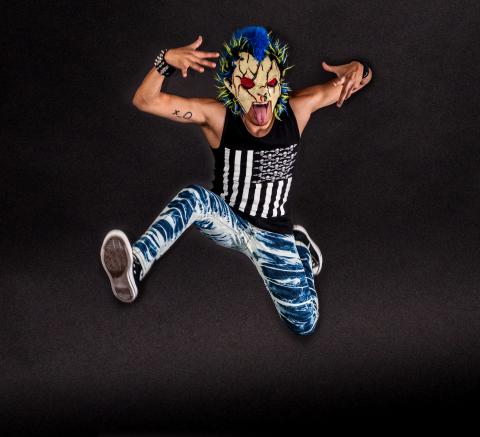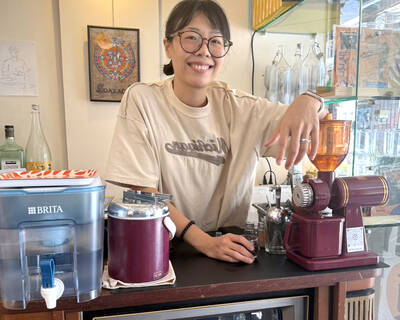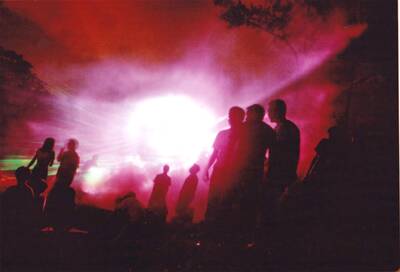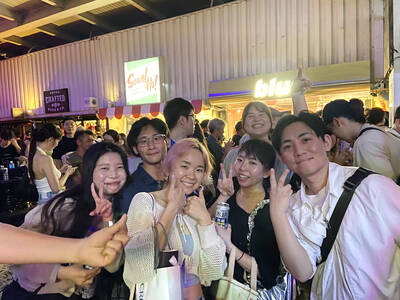In 2010, DJ BL3ND (real name withheld) started making videos and posting them to YouTube. At first, no one paid any attention to the teenager jumping around his room to hardcore electronic music. Then, at his parents’ insistence, he put on a mask that looked like a combination of Halloween’s Michael Meyers stitched together with Chuckie from Child’s Play and a 1980s glam rocker.
BL3ND danced hyperactively around his room in the mask to hard beats, but this time, something struck a chord, especially for rebelling teens. Soon, his viral YouTube videos had millions of hits and BL3ND was an in-demand DJ charging outrageous fees and traveling the globe. DJ BL3ND will be performing at ATT Show Box tonight.
“I never intended to be a mysterious person behind a mask,” BL3ND said in an e-mail interview with the Taipei Times.

Photo courtesy of DJ BL3ND
Now that he is known for his many different masks, BL3ND refuses to take them off. “I can express myself better with the mask on. Without a mask I’m just a normal person who you wouldn’t expect to be crazy,” he said.
Even though BL3ND has millions of fans on Facebook and across the globe, he claims he is a normal guy who likes to spend time with his family, dogs and friends when not listening to rock, hip-hop, old school jams and electronic music.
Like DJ Steve Aoki, who mixes two songs together and then hypes up the crowds by spraying champagne or throwing cake at them, DJ BL3ND makes sure that audiences get their money’s worth when they come to his shows by giving them his all. This means sometimes jumping out onto the crowd.
“Yes, I’ve gotten injured before. Not by crowd surfing, but by slipping on water and falling on a bass bottom at a show,” BL3ND said. “I ran back to the stage like nothing had happened, but I was actually just holding on to the pain.”
While BL3ND believes that image and music are both equally important, he knows deep down that anyone can be a viral video or two away from stardom. To the people who want to break into the DJ industry, his advice is: “Push a little harder to things you wouldn’t normally do.”
■ BL3ND performs tonight from 9:30pm to 4am at ATT Show Box, 7F, 12 Songshou Rd, Taipei City (台北市松壽路12號7樓). Tickets can be purchased at the door or iBon/FamiPorts for NT$2,000.

Cheng Ching-hsiang (鄭青祥) turned a small triangle of concrete jammed between two old shops into a cool little bar called 9dimension. In front of the shop, a steampunk-like structure was welded by himself to serve as a booth where he prepares cocktails. “Yancheng used to be just old people,” he says, “but now young people are coming and creating the New Yancheng.” Around the corner, Yu Hsiu-jao (饒毓琇), opened Tiny Cafe. True to its name, it is the size of a cupboard and serves cold-brewed coffee. “Small shops are so special and have personality,” she says, “people come to Yancheng to find such treasures.” She

Late last month Philippines Foreign Affairs Secretary Theresa Lazaro told the Philippine Senate that the nation has sufficient funds to evacuate the nearly 170,000 Filipino residents in Taiwan, 84 percent of whom are migrant workers, in the event of war. Agencies have been exploring evacuation scenarios since early this year, she said. She also observed that since the Philippines has only limited ships, the government is consulting security agencies for alternatives. Filipinos are a distant third in overall migrant worker population. Indonesia has over 248,000 workers, followed by roughly 240,000 Vietnamese. It should be noted that there are another 170,000

In July of 1995, a group of local DJs began posting an event flyer around Taipei. It was cheaply photocopied and nearly all in English, with a hand-drawn map on the back and, on the front, a big red hand print alongside one prominent line of text, “Finally… THE PARTY.” The map led to a remote floodplain in Taipei County (now New Taipei City) just across the Tamsui River from Taipei. The organizers got permission from no one. They just drove up in a blue Taiwanese pickup truck, set up a generator, two speakers, two turntables and a mixer. They

Hannah Liao (廖宸萱) recalls the harassment she experienced on dating apps, an experience that left her frightened and disgusted. “I’ve tried some voice-based dating apps,” the 30-year-old says. “Right away, some guys would say things like, ‘Wanna talk dirty?’ or ‘Wanna suck my d**k?’” she says. Liao’s story is not unique. Ministry of Health and Welfare statistics show a more than 50 percent rise in sexual assault cases related to online encounters over the past five years. In 2023 alone, women comprised 7,698 of the 9,413 reported victims. Faced with a dating landscape that can feel more predatory than promising, many in